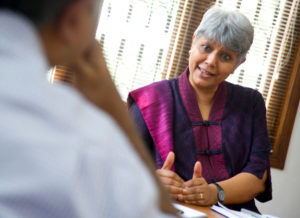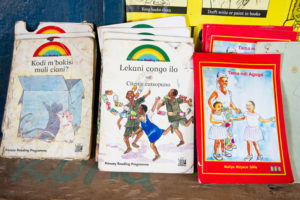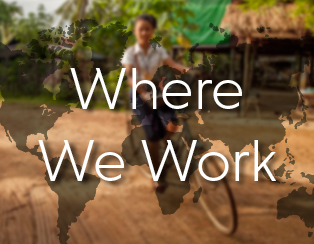After reading gains in Zambia, education expert explains how to sustain progress
By Natalie LovenburgJune 28, 2017
Q&A with Renuka Pillay, Director Read to Succeed project
Primary school students in more than 1,200 primary schools in Zambia are reading better than ever before.
There was an 809 percent jump in reading comprehension among second graders in schools supported by the U.S. Agency for International Development-funded Read to Succeed program, according to an early grade reading baseline assessment in 2012 to an endline assessment in 2016 conducted by the program.
Based the past five years, the program, which is implemented by Creative Associates International, has built capacity in the Ministry of General Education and improved reading using a phonics-based approach among learners in grades 1 to 4 in their local Zambian languages.
After years of successful collaboration, the Read to Succeed Zambia project will transition in June from the project team into the hands of Zambian government. Renuka Pillay, Project Director for USAID’s Read to Succeed project in Zambia, says that from day one sustainability has been at the heart of the project, with the Ministry of General Education taking the lead in policy changes that support student learning.
Pillay shares lessons learned for improving early grade literacy education based on Creative’s “whole school, whole teacher, whole learner” approach and preparing to sustain these gains.
With more than 16 years of experience implementing projects focused on education, psychosocial support, HIV mitigation, and post-conflict reconstruction in Zambia, Uganda, Tanzania, Pillay has supported learning materials development and policy dialogues with the Ministry of Education, among other critical areas.
Explore the special reports: “Zambia: Transforming education, creating a nation of readers” and “Zambia: Turning the page for better schools.”
USAID’s Read to Succeed project helped to ensure delivery of quality of education, with a particular focus on early grade reading. What did the project do to help ensure those gains are sustainable?

Pillay: Read to Succeed has five fundamental guiding principles called “The Five S’s” that informed the project from the very beginning and throughout its implementation at various stages. I feel the projects exit strategy and sustainability plan are all linked into these main principles.
- Shared Goals. One of the first things Read to Succeed did was to develop shared goals with the Ministry of General Education. This was in regard to teaching literacy in Zambia primary schools.
- Strategic Approach. One of the things the project staff developed was a National Literacy Framework with the Ministry of General Education. It is significant for a government to take on such an intervention – at a national level and one that a project proposes. It is a testimony to the way in which Read to Succeed works.
- Systemic Approach. The way the project worked was to have government counterparts—from the Departments of Curriculum Development, Teacher Education and Standard and Quality—work on committees with them as members of the technical team to ensure the interventions were Zambian-led.
- Scale-up Nationally. By ensuring there were opportunities in the design for scale-up, the project made sure to use government structures and to not create new structures. This helped to ensure that the model of training was in line with what the government could financially afford for future trainings and retooled the national trainers as facilitators.
Given that the main actors in the project were government officials from all levels–from the national, regional, provincial, district and zonal levels–they were all part of the existing system.
Under the leadership of Dr. Tassew Zweedie, Read to Succeed’s Chief of Party, the project ensured that government was in the driver’s seat. From the beginning and throughout the life of the project, there was a strong level of collaboration and capacity building in order to ensure a successful transition of ownership and each level of the government has a defined role moving forward.
The value is that the government and other key partners, who are also actors in education, found this process to be very inclusive and it shines a light on the way forward for other programs being implemented.
The Government of Zambia was at the forefront of Read to Succeed’s work every step of the way. In your view, what role should governments play in ensuring quality education for all?
Pillay: One of the most significant aspects of the project that we’ve learned is that bringing government officials to the table at the outset, works to improve the outcome of a project.
This opportunity for collaboration was evidenced within the technical working groups, which Ministry officials chaired. Furthermore, at the Provincial level there was integration of the Read to Succeed innovations into their respective work plans. This was a good indication of the ownership of the Read to Succeed interventions and the value was appreciated.
On the policy level regarding literacy, we need to ensure that countries set bench marks to measure achievement at different grade levels. The Read to Succeed project has worked closely with the government to propose suitable, realistic benchmarks for reading at Grade 2 level.
It’s critical for governments to engage among each other with efficacy and efficiency to ensure flow of funds at all levels: teacher recruitment and deployment; upgrading, promotions and rewards for educators; and quality assurance, etc. This closer inter-ministerial collaboration creates a more supportive system in which education reforms can be embedded to deliver quality education.
The Read to Succeed Project included outreach to orphans and vulnerable children and adolescent peer counseling to spread healthy behaviors and support vulnerable students. What is the connection between health and education? Why pair them together?

Pillay: The integration and focus on school health, well-being and the education of children is a critical topic that warrants more attention. There needs to be a closer link between health and education.
With systems in Africa particularly, not having a robust early childhood development component is a challenge. The children are coming straight from the household to the classroom without any readiness skills, such as understanding one’s body. Nutrition can be a concern as can any sort of special needs, such a visual impairment.
Having early childhood education to prepare young students is often a neglected aspect in school systems. Issues stemming from this lack of early education roll up to the primary school cycle.
Applying a “whole school, whole teacher, whole learner” approach to education, like the Read to Succeed project did, involves and mobilizes the community, including parents and partners, to work together to tackle issues like gender barriers, nutrition, good hygiene and cleanliness.
This Read to Succeed project provided critical psychosocial care and support, called Learner Support and Services, for vulnerable children to have the more holistic well-being and to prepare them for adolescence. The success of this intervention is that the Agents of Change, who were trained by the project, were students of the school, who provided informal peer-support to others.


